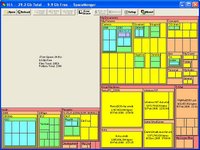My usage of drives and hardware is outgrowing the design of the typical PC. I use an extremely broad range of software and it is all installed on my hard disk. My 60 Gb drive is partitioned for convenience and performance, but there is a huge amount of risk in the use of a single drive. I do have a second, USB-connected, drive that I perform regular backups to but it has become so essential that it tends to end up plugged in and serving an almost permanent role.
Recently I have acquired a 2.5" Drive enclosure from
TigerDirect.ca and it has become my new backup device. It is 40Gb and USB-powered and it's sole purpose is to keep my data safe. The challenge is that data backup is only half of the problem or concern.
My secondary concern and biggest inconvenience is keeping a working backup of my PC, my operating system and applications. For me it takes days to rebuild my particular system, the effort is extreme and when it happens I react as if I'd lost a pet. The use of Symantec Ghost, available with Norton Systemworks or seperately, is time-consuming but very worth it. Acronis TrueImage is an alternative that performs the backup without the down-time, I commend them for this advancement and this will be my next purchase.
There's more that can be done to improve the experience and safeguard our digital lives. The development of
Network Attached Storage (NAS) devices is a wise choice and they can replace the requirement for a big drive on your PC, serving everyone in your home or office, but do not use these for application storage, keep it down to data. They don't eliminate the risk of data loss, they centralize it. For a small business or private person these are a an alternative, but you need to protect your data and find a method of backup that serves you.
What I would like to suggest to the PC and NAS manufacturers is a change in design. The corporate environment has the option of
Redundant Array of Independent Disks (RAID) configured servers with multiple drives that provide redundancy to safeguard data. This would be a welcome addition to the SOHO environment. What I propose is that in PCs, desktop systems, that the single drive arrangement (a 3.5" drive) be replaced with 2 2.5" drives which can be configured in a simple manner to provide data-storage and redundant data backup. While this might be utilized as a RAID 0 solution, a relatively simple mirroring of one drive to the other, the user may opt for the second drive to be a be a safe storage location for a manual backup (such as TrueImage or Ghost), optimizing the space used. Laptop users would be able to compromise weight for storage in a similar design, but they might prefer to go for the current solutions, an external USB-connected drive. The RAID design could be implemented with NAS devices as well with relative simplicity.
There's another suggestion I might make for performance reasons. Build drives with the capability to have on-board antivirus protection and scanning. Yes, ON-THE-DRIVE. My system has been checking my system since midnight last night and is up-to 426,000 files. It is not done. Under this design the drive itself would perform anti-virus scans while the user is not actively using the device. There would be a manner by which the user's antivirus application could post updates to the drive and the drive would use this information to protect the system. This would also boost performance as the channel that is used to communicate with the drive would not be used to perform the scan.
It might be suggested that these complications to the design might be adding to the costs, it will. This is inevidible. The unfortunate truth is that as the agression of the virus creators and the resulting attacks is on the rise and the anarchy involved threatens our enjoyment of technology. The Internet was created to be an improvement on sharing information and resources around the world. It is a valuable tool to the life and liberty of many. It is also the source of risk. Protect yourself.
Recommended Tools:IOGear ION Drive (USB-Connected):
linkAcronis TrueImage:
linkSymantec/Norton Products:
link
 #1. SpaceMonger (link)
#1. SpaceMonger (link)